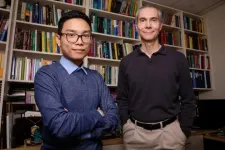(Press-News.org) An international team of scientists have explained how legume trees are key in liberating minerals locked in iron minerals and the benefits are passed on to nearby trees
The research shows that the trees are able to alter their soils microbiome in a way that increases access to nutrients and supports growth
The findings provide new insight into the role of these trees in safeguarding the function of tropical forests and sustainable reforestation
Researchers have found that nitrogen-fixing legume trees can support themselves and surrounding trees not only with increased access to nitrogen, but with other key nutrients through enhanced mineral weathering.
The team, led by the University of Sheffield and the Smithsonian Tropical Research Institute, have published their findings in the journal PNAS which provide new insights into the role of nitrogen-fixing trees in safeguarding the function of tropical forests within the biosphere.
The findings may also help inform practitioners and policy makers on how best to approach reforestation on degraded land and help meet climate change mitigation targets.
The researchers discovered how the nitrogen-fixing legume trees overcome the constraints of growing on ancient, nutrient-poor tropical soils by accelerating weathering processes, releasing vital nutrients for themselves and surrounding trees in the forest.
The trees are able to accelerate mineral weathering processes by locally acidifying the soil and adjusting the carbon to nitrogen ratio of the soil, ultimately changing the microbial community.
This change in soil microbes improves access to nutrients and favours a type of bacteria that breaks down iron, releasing iron-bound minerals critical to tree growth.
Legume trees are also particularly important in the process of forest recovery because they are able to supply fresh nitrogen into soils, which gets broken down by bacteria and utilised by the legume tree and trees around it.
Dr Dimitat Epihov, lead author of the research from the University of Sheffield's Leverhulme Centre for Climate Change Mitigation, said: "Our research shows that legume trees not only provide valuable nitrogen through their symbioses with bacteria that live in their roots, but interact with free-living soil bacteria allowing nutrients to be chemically released.
"We discovered the abundance of a novel group of acid-loving bacteria, key in liberating minerals locked in iron minerals beneath legume trees, and that those benefits are passed on to nearby trees."
Professor David Beerling, Director of the University of Sheffield's Leverhulme Centre for Climate Change Mitigation, said: "By using advanced genomic sequencing techniques we have addressed a long standing puzzle of how fast growing trees access sufficient nutrients to support their growth from nutrient-poor soils.
"The answer, it turns out, is to exploit specialised consortia of soil microbes whose metabolism allows them to efficiently break down rocks and extract nutrients they contain."
INFORMATION:
The study was carried out in young regrowing forests at the Agua Salud Project in Panama, directed by the Smithsonian Tropical Research Institute.
For further information please contact: Emma Griffiths, Media and PR Assistant, University of Sheffield, 0114 222 1034, e.l.griffiths@sheffield.ac.uk
Notes to editors
The University of Sheffield
With almost 29,000 of the brightest students from over 140 countries, learning alongside over 1,200 of the best academics from across the globe, the University of Sheffield is one of the world's leading universities.
A member of the UK's prestigious Russell Group of leading research-led institutions, Sheffield offers world-class teaching and research excellence across a wide range of disciplines.
Unified by the power of discovery and understanding, staff and students at the university are committed to finding new ways to transform the world we live in.
Sheffield is the only university to feature in The Sunday Times 100 Best Not-For-Profit Organisations to Work For 2018 and for the last eight years has been ranked in the top five UK universities for Student Satisfaction by Times Higher Education.
Sheffield has six Nobel Prize winners among former staff and students and its alumni go on to hold positions of great responsibility and influence all over the world, making significant contributions in their chosen fields.
Global research partners and clients include Boeing, Rolls-Royce, Unilever, AstraZeneca, Glaxo SmithKline, Siemens and Airbus, as well as many UK and overseas government agencies and charitable foundations.
In the United States, one in 10 babies are born too soon, resulting in complications that can affect their locomotor development and influence such simple tasks as balance, walking and standing later in life. A new peer-reviewed study by Children's National Hospital, published in the Proceedings of the National Academy of Sciences of the United States of America (PNAS), explores exactly what neural circuitry of the cerebellum is affected due to complications that occur around the time of birth causing these learning deficits, and finds a specific type of neurons -- Purkinje cells -- to play a central role.
Up until now, there has been a sparsity of techniques available to measure neuronal ...
American adults without a college degree have experienced greater reductions in life expectancy when compared to their more-educated counterparts, USC and Princeton researchers have found.
The study reveals that after nearly a century of declining mortality up to the late 1990s, the progress continued into the 21st century for more-educated Americans but stalled for the population as a whole and reversed for the two-thirds of Americans who do not have a college degree.
The study appeared Monday in the Proceedings of the National Academy of Sciences.
The ...
Malaria is the deadliest pathogen in human history. Nearly half the people on Earth are at risk of contracting the disease from the parasites that cause it. But humans aren't the only ones who can get these parasites--different forms are found in other animals, including birds. By studying the DNA of those strains, scientists can get a better picture of how malarial parasites live, which may give clues on how to stop the disease. In a new paper in PNAS, researchers analyzed blood samples of more than 1,000 species of birds from the Andes looking for malaria; they found that the strains of malaria present in a local area don't always neatly align with the types of birds living there.
"Traditionally, we thought that there's ...
(Boston)--Despite the positive advances that anti-human immunodeficiency virus (HIV) therapy, commonly called anti-retroviral therapy (ART) or highly active antiretroviral therapy (HAART), has had on the life expectancy of HIV-positive people, finding a cure for HIV or acquired immunodeficiency syndrome (AIDS) has remained elusive.
"One of the major challenges in curing HIV is that there is a persistent latent reservoir of virus that is not targeted by current antiretroviral treatments and is hidden from immune cells. When treatment is interrupted, this reservoir of the virus allows the HIV ...
Here is a link to a free Altmetric Report on this Research Output
Aging-US published "Hyperbaric oxygen therapy increases telomere length and decreases immunosenescence in isolated blood cells: a prospective trial" which reported that the aim of the current study was to evaluate whether hyperbaric oxygen therapy (HBOT) affects telomere length (TL) and senescent cell concentrations in a normal, non-pathological, aging adult population.
Thirty-five healthy independently living adults, aged 64 and older, were enrolled to receive 60 daily HBOT exposures.
Whole blood samples were collected at baseline, at the 30th and 60th session, and 1-2 weeks following the last HBOT session.
Telomeres length of T helper, T cytotoxic, natural killer and ...
CHAMPAIGN, Ill. -- Tiny fluorescent semiconductor dots, called quantum dots, are useful in a variety of health and electronic technologies but are made of toxic, expensive metals. Nontoxic and economic carbon-based dots are easy to produce, but they emit less light. A new study that uses ultrafast nanometric imaging found good and bad emitters among populations of carbon dots. This observation suggests that by selecting only super-emitters, carbon nanodots can be purified to replace toxic metal quantum dots in many applications, the researchers said.
The findings, published in the Proceedings of the National Academy of Sciences, ...
About one billion people worldwide are at risk for schistosomiasis -- a debilitating disease caused by parasitic worms that live in fresh water and in intermediate snail hosts. A new study finds that the transmission risk for schistosomiasis peaks when water warms to 21.7 degrees centigrade, and that the most effective interventions should include snail removal measures implemented when the temperature is below that risk threshold.
The Proceedings of the National Academy of Sciences published the results, led by Emory University, the University of South Florida and the ...
When it comes to microelectronics, there is one chemical element like no other: silicon, the workhorse of the transistor technology that drives our information society. The countless electronic devices we use in everyday life are a testament to how today very high volumes of silicon-based components can be produced at very low cost. It seems natural, then, to use silicon also in other areas where the properties of semiconductors -- as silicon is one -- are exploited technologically, and to explore ways to integrate different functionalities. Of particular interest in this ...
Determining how rapidly the universe is expanding is key to understanding our cosmic fate, but with more precise data has come a conundrum: Estimates based on measurements within our local universe don't agree with extrapolations from the era shortly after the Big Bang 13.8 billion years ago.
A new estimate of the local expansion rate -- the Hubble constant, or H0 (H-naught) -- reinforces that discrepancy.
Using a relatively new and potentially more precise technique for measuring cosmic distances, which employs the average stellar brightness within giant elliptical galaxies as a rung on the distance ladder, astronomers calculate a rate -- 73.3 kilometers per second per megaparsec, give or take 2.5 km/sec/Mpc -- that lies in the middle of three ...
Inflammation in the body has been linked to the intensity of tobacco smoking among people with HIV, according to a team of University of Massachusetts Amherst researchers.
Krishna Poudel, associate professor of community health education in the School of Public Health and Health Sciences, and colleagues reported positive linear relationships between intensity, duration and pack-years of smoking and inflammation in HIV-positive people. They believe it to be the first, more thorough examination of specific smoking-related variables with the levels of inflammation in this group, while also taking into account highly active antiretroviral therapy (HAART) and other important factors.
The study's findings ...





